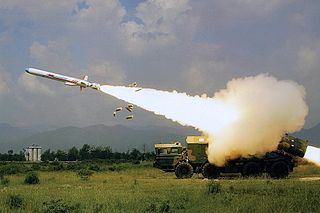
A cruise missile is an unmanned self-propelled guided vehicle that sustains flight through aerodynamic lift for most of its flight path and whose primary mission is to place an ordnance or special payload on a target. Cruise missiles are designed to deliver a large warhead over long distances with high precision. Modern cruise missiles are capable of traveling at high subsonic, supersonic, or hypersonic speeds, are self-navigating, and are able to fly on a non-ballistic, extremely low-altitude trajectory.

The SY, and HY series were early anti-ship cruise missiles (ASCM) developed by the People's Republic of China from the Soviet P-15 Termit missile. They entered service in the late 1960s and remained the main ASCMs deployed by the People's Liberation Army Navy through the 1980s. The missiles were used by the PRC and export customers to develop land-attack missiles.

The People's Republic of China has developed and possesses weapons of mass destruction, including chemical and nuclear weapons. The first of China's nuclear weapons tests took place in 1964, and its first hydrogen bomb test occurred in 1966 at Lop Nur. Tests continued until 1996, when the country signed the Comprehensive Nuclear-Test-Ban Treaty (CTBT), but did not ratify it. China acceded to the Biological Weapons Convention (BWC) in 1984 and ratified the Chemical Weapons Convention (CWC) in 1997. Since 2020, China has been wielding a nuclear triad, alongside four other countries.

The Novator KS-172 was a Russian air-to-air missile project designed as an "AWACS killer" at ranges up to 400 km. The missile had various names during its history, including K-100, Izdeliye 172, AAM-L (RVV-L), KS–172, KS-1, 172S-1 and R-172. The airframe appears to have been derived from the 9K37 Buk surface-to-air missile (SAM) but development stalled in the mid-1990s for lack of funds. It appears to have restarted in 2004 after a deal with India, who wants to produce the missile in India for their Su-30MKI fighters. Development has ceased and the project is closed.

The PL-12 is an active radar-guided beyond-visual-range air-to-air missile developed by the People's Republic of China. It is considered comparable to the US AIM-120 AMRAAM and the Russian R-77.

The Xi'an H-6 is a twin-engine jet bomber of the Chinese People's Liberation Army Air Force (PLAAF). The H-6 is a license-built version of the Soviet Tupolev Tu-16 and remains the primary bomber aircraft of the People's Republic of China.

The Kh-31 is a Soviet and Russian air-to-surface missile carried by aircraft such as the MiG-29, Su-35 and the Su-57. It is capable of Mach 3.5 and was the first supersonic anti-ship missile that could be launched by tactical aircraft.

The Kh-59 Ovod is a Russian cruise missile with a two-stage solid-fuel propulsion system and 200 km range. The Kh-59M Ovod-M is a variant with a bigger warhead and turbojet engine. It is primarily a land-attack missile; the Kh-59MK variant targets ships.
The YJ-7 is a Chinese subsonic anti-ship missile. It is manufactured by the Third Academy of the China Aerospace Science and Industry Corporation (CASIC). The export version of the YJ-7 is the C-701.

The YJ-62 is a Chinese subsonic land-attack and anti-ship cruise missile. It is manufactured by the China Aerospace Science and Industry Corporation Third Academy.

The YJ-91 is an anti-radiation air-to-surface cruise missile produced by the People's Republic of China. It is a derivative of the Zvezda-Strela Kh-31P anti-radiation variant.

The YJ-12 is a Chinese supersonic anti-ship cruise missile manufactured by China Aerospace Science and Industry Corporation (CASIC).
The HN missiles are a series of turbofan powered Chinese land attack cruise missiles, based on the X-600.

The YJ-83 is a Chinese subsonic anti-ship cruise missile. It is manufactured by the China Aerospace Science and Industry Corporation Third Academy.
The Type 055 destroyer is a class of stealth guided-missile destroyers constructed for the Chinese People's Liberation Army Navy (PLAN). It has a multi-mission design; the combination of sensors and weapons provides a main role of area air defence, with anti-submarine warfare capabilities surpassing previous Chinese surface combatants.

The ASM-3 is a supersonic anti-ship missile being developed by Mitsubishi Heavy Industries to replace the ASM-1 and ASM-2 missiles. The major launch platform is the Mitsubishi F-2. Planned Initial Operational Capability was 2016. The missile will be used by the Japan Air Self-Defense Force. It can attack not only ships, but also ground targets. Since the original model of ASM-3 had a short range of 200 km, it was not deployed immediately, and an improved model was developed from 2017 to 2020, and deployment of ASM-3A with a range of about 300~400 km started in 2021. In the future, it may also have a range of 400 km or more.
The YJ-18 is a Chinese anti-ship cruise missile.

A hypersonic weapon is a weapon capable of travelling at hypersonic speed, defined as between 5 and 25 times the speed of sound.













